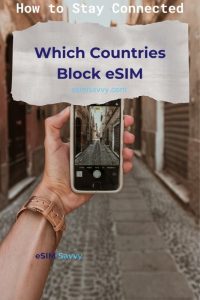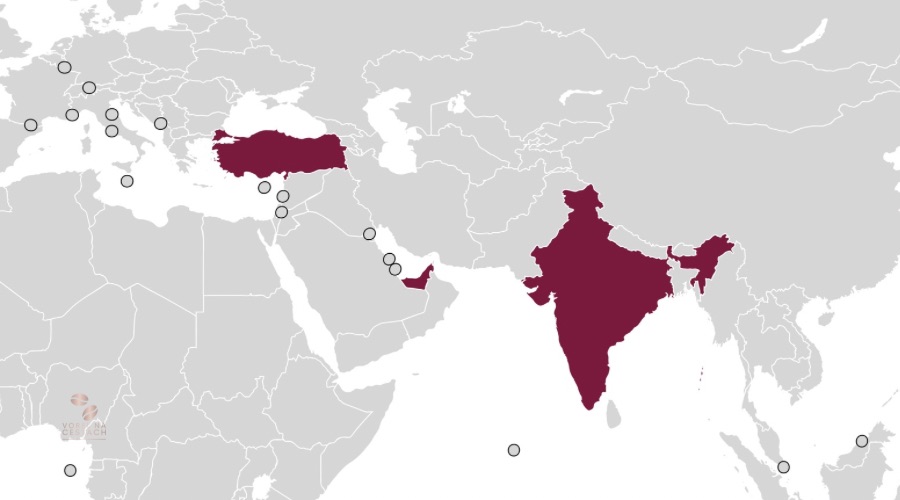In a previous article, I explained what an eSIM is, where to buy it and how to activate one (see “The Ultimate eSIM Guide“). However, not all countries embrace eSIM technology. Some nations have chosen to restrict or even ban the sale of eSIM services altogether. Why have they taken this approach, and what does it mean for travellers heading to these destinations?
Note: Some links in this article are affiliate links. If you click on a link and purchase a service, I may earn a small commission at no extra cost to you. It helps me keep the blog running.
Don’t worry if your country is on the list. There’s always a solution or a workaround. This article provides a clear list of countries that prohibit eSIM purchases, along with a helpful FAQ to equip you with everything you need to know before you depart and upon arrival.
- Why Some Countries Block eSIMs
- Which Countries Block eSIMs?
- Which eSIM Services Are Blocked?
- What Does This Mean for Us, the Users?
- How to Prepare for Your Trip (before departure)
- What to Do if You Are Already There
- Where to Find a List of eSIM Providers
- Will More Countries Ban eSIM Products?
- How to Check if Your eSIM is Working
- Final Recommendations

Why Some Countries Block eSIMs
At first glance, one might think, “eSIM technology is truly revolutionary!” Indeed, it’s hard to argue against the benefits of eSIMs, especially for us travellers seeking budget-friendly internet access while exploring far-off lands.
However, for local mobile operators, the eSIMs present a complex challenge, a double-edged sword, if you will. The most astute mobile operators (carriers) quickly adopted this innovative technology, capitalising on its potential and reaping substantial rewards. In contrast, others perceive eSIMs as a formidable threat to their established business models.
Governments and telecom regulators often block eSIM services for several key reasons:
- Protecting the Domestic Market and Operator Revenues
Regulators aim to protect local operators from being undercut by cheaper foreign eSIM providers. If both tourists and domestic customers start using low-cost eSIMs, local carriers may experience reduced revenues, which could jeopardise their investments in building and improving national mobile networks. - Security and Subscriber Verification
Some countries enforce strict “Know Your Customer” (KYC) rules, requiring every SIM card to be registered under the user’s real name. Many global eSIM providers do not impose stringent identity verification, leading authorities to block their services in order to maintain control over who uses mobile networks. - Control Over Censorship and Content
In certain regions, mobile networks collaborate with government censors to filter or block specific websites and applications. By blocking foreign eSIMs, whose traffic is harder to monitor, governments can prevent users from circumventing local censorship controls.
Which Countries Block eSIMs?
India
On January 4, 2024, India’s Department of Telecommunications (DoT) issued an order requiring Apple and Google to remove several popular eSIM apps, including Airalo and Holafly, from their local app stores.
Additionally, all Indian Internet Service Providers (ISPs), both mobile and fixed-line, were instructed to block access to the corresponding websites.
During my visit to India, I found that when I attempted to open the Airalo, Nomad, or Holafly apps, I received an “unable to connect” error, and their websites were completely inaccessible.
United Arab Emirates
The UAE has not officially announced a ban on eSIMs. However, during my visits in April 2024 and April 2025, I was unable to access the Airalo, Nomad, or Holafly apps while connected to Etisalat’s network. Their websites were also unreachable.
Several other travellers reported the same issue with eSIMs from different providers on various internet forums.
Türkiye
On July 10, 2025, Türkiye’s regulatory body, the Information and Communication Technologies Authority (BTK), blocked access to the websites and apps of eight international eSIM providers: Airalo, Saily, Holafly, Nomad, Instabridge, Mobimatter, Alosim, and BNESIM. This action was confirmed by both the providers and several foreign news outlets.

Which eSIM Services Are Blocked?
In the countries mentioned above, attempting to visit the online portals of major eSIM providers such as Airalo, Holafly, Nomad, or Saily will often result in a “page not found” error or a message indicating that the site is unavailable.
Additionally, when opening their mobile apps, users typically encounter an “offline” error, which suggests that there is no internet access to complete the activation process.
Access to the eSIM provider’s website and mobile applications is blocked. However, you can still use your data, or SMS and calls.
What Does This Mean for Us, the Users?
Stay calm and don’t panic. Even in countries with restrictions, travellers can still use eSIM to access the internet and avoid high roaming charges. What is not possible is to purchase a new eSIM product, check the balance in real time or top up.
Here are some solutions on how to still enjoy cheaper mobile data:
- Buy and Install Your eSIM Before You Travel
Activate your eSIM profile at home (or in your hotel before departure) using a stable Wi-Fi connection. - Try Alternative eSIM Providers
Not every provider is blocked everywhere. Lesser-known services, such as EtravelSIM, Esimatic, or OneSimCard, may still be viable options. (See ”Providers” in the menu.)
However, this is somewhat risky, as they may be blocked soon as well. - Use a VPN
A virtual private network (VPN) can sometimes help bypass local restrictions.
However, be aware that some countries, notably the UAE, also restrict VPN usage.
How to Prepare for Your Trip (before departure)
Since you’re reading this, you’ve already begun your planning. Follow these steps to ensure uninterrupted connectivity during your travels:
- Check if your destination blocks eSIM providers
Identify which services may be restricted in your destination. - Purchase and activate an eSIM before departure
Ensure you complete this task using your reliable home Wi-Fi connection before you depart. - Note your eSIM plan’s data allowances
Write down your data allowance, as well as any included SMS or call minutes. Keep track of data spent directly in your phone’s settings. You may not be able to monitor your usage in the app or on the website while you are abroad. - Save manual APN and network settings
Most eSIM providers will include this information in their emails, eSIM plan details or apps. Store it somewhere safe on your phone in case you need to configure it manually later.
Enjoy Your Trip!
Editor’s tip: Buy a bigger data plan in advance and install it before you leave. This way, you’ll be ready to connect the moment you arrive!
What to Do if You Are Already There
If you arrive at your destination and find that your eSIM provider’s website or app is blocked while using hotel or airport Wi-Fi, don’t worry. You still have several options:
- Switch to a different, less-known eSIM provider
Consider using services like EtravelSIM or Esimatic. (See ”Providers” in the menu.) - Connect via VPN
Services such as Surfshark or NordVPN can assist you, although keep in mind that this may not work in the UAE. - Rent a pocket Wi-Fi Device
These portable hotspots come with a local SIM card already installed. - Purchase a local prepaid SIM
Local SIM cards are widely available at airports and shops throughout the area. However, be prepared to provide your passport for registration and identity verification purposes.
Where to Find a List of eSIM Providers
New eSIM companies are continually emerging. I maintain my own list of eSIM providers that I have tested. You can find this list under the ”Providers” menu, along with my reviews of their products.
Will More Countries Ban eSIM Products?
This situation can change at any moment, making it difficult to predict which country might be next to block eSIM services. I regularly monitor the global eSIM landscape and will update subscribers via email and in articles whenever new developments occur.
How to Check if Your eSIM is Working
Confirming if your eSIM is working is very easy. Once you land, turn off flight mode, and your eSIM should automatically connect to a local mobile network within seconds or a few minutes.
If you had mobile data disabled before your flight, please ensure it is enabled now. Soon, you should see the 4G or 5G icon appear on your device.

Final Recommendations
The recent eSIM blocks in Türkiye (effective July 10, 2025), India (effective January 4, 2024), and the UAE underscore the importance of not leaving your eSIM purchase and installation until the last minute.
Ensure you download and install your eSIM profile at home on a secure Wi-Fi network. If you find yourself abroad without access to a working eSIM, you have alternative options: consider using a local prepaid SIM card or renting a pocket Wi-Fi hotspot.
If you have any questions I haven’t addressed, feel free to leave them in the comments below!
